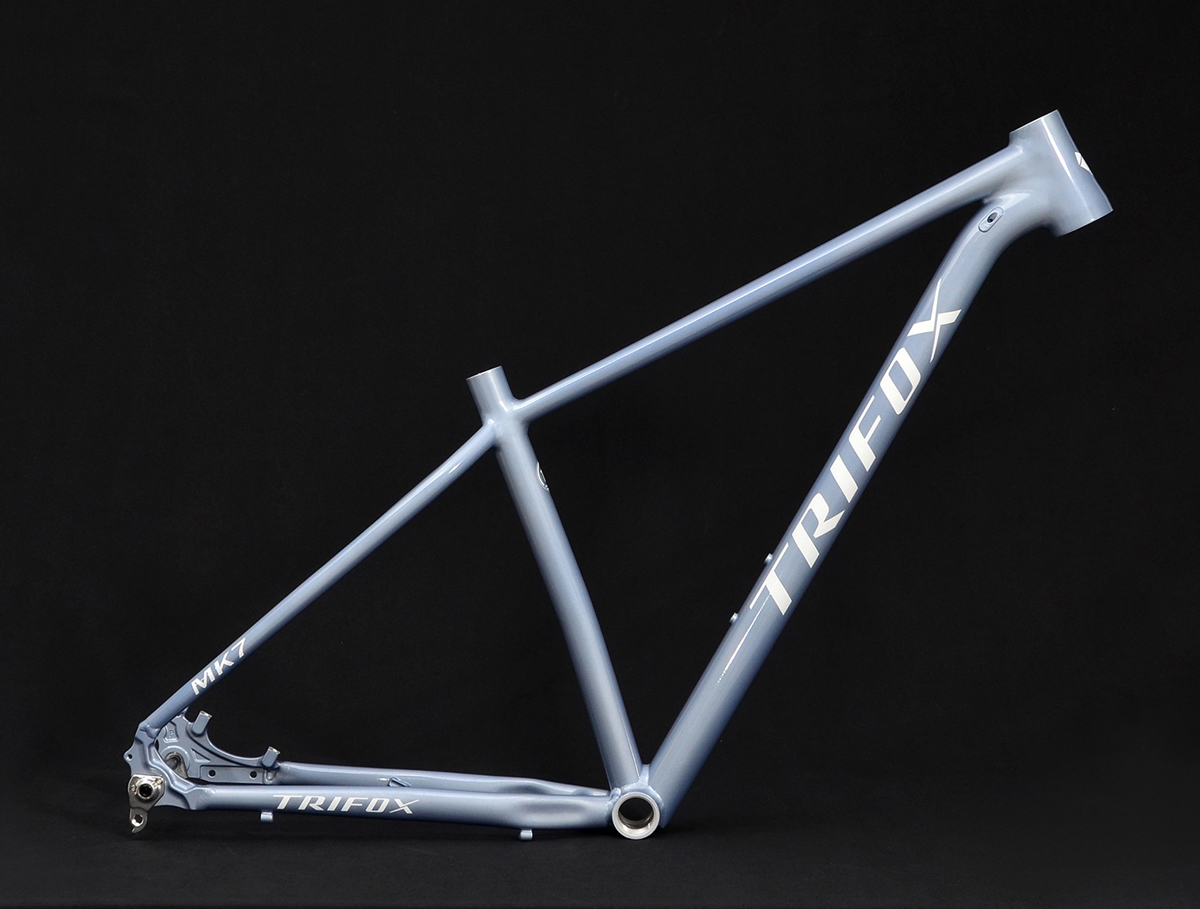
Mountain biking thrives on durability, performance, and value—and the Trifox MK7 Ultralight Aluminum Hardtail Frame delivers all three. Priced at an unbeatable $189, this 29er Boost frame is a steal for riders building or upgrading a trail-ready rig without breaking the bank. Why Choose a 29er Boost Hardtail? 29-inch wheels roll over roots and rocks with ease, while Boost hub spacing (148mm rear) ensures stiffer wheels, better tire clearance, and compatibility with modern drivetrains. The MK7’s lightweight 6061 aluminum frame strikes a perfect balance between strength and agility, weighing just 1.8kg (size M). Its slack head tube angle (67.5°) and short chainstays (430mm) prioritize stability on descents and playfulness on climbs. Features That Shine The MK7 is built to handle rugged terrain. Key upgrades include: - Internal Cable Routing: Clean looks and protection from mud/debris. - Tapered Head Tube: Compatible with modern forks for precise steering. - Universal Derailleur Hanger: Supports 1x or 2x setups. - Thru-Axle Compatibility: Boosts stiffness and control. Versatility Meets Affordability Hardtails excel at efficiency and simplicity, making the MK7 ideal for cross-country, trail riding, or even bikepacking. Pair it with a 120-140mm fork, and you've got a budget-friendly beast ready for technical singletrack. At $189, the Trifox MK7 is a rare blend of quality and affordability. Whether you're a beginner building your first MTB or a seasoned rider crafting a lightweight backup, this frame is a smart investment. Don’t miss this limited-time deal—explore the MK7 here and hit the trails with confidence!
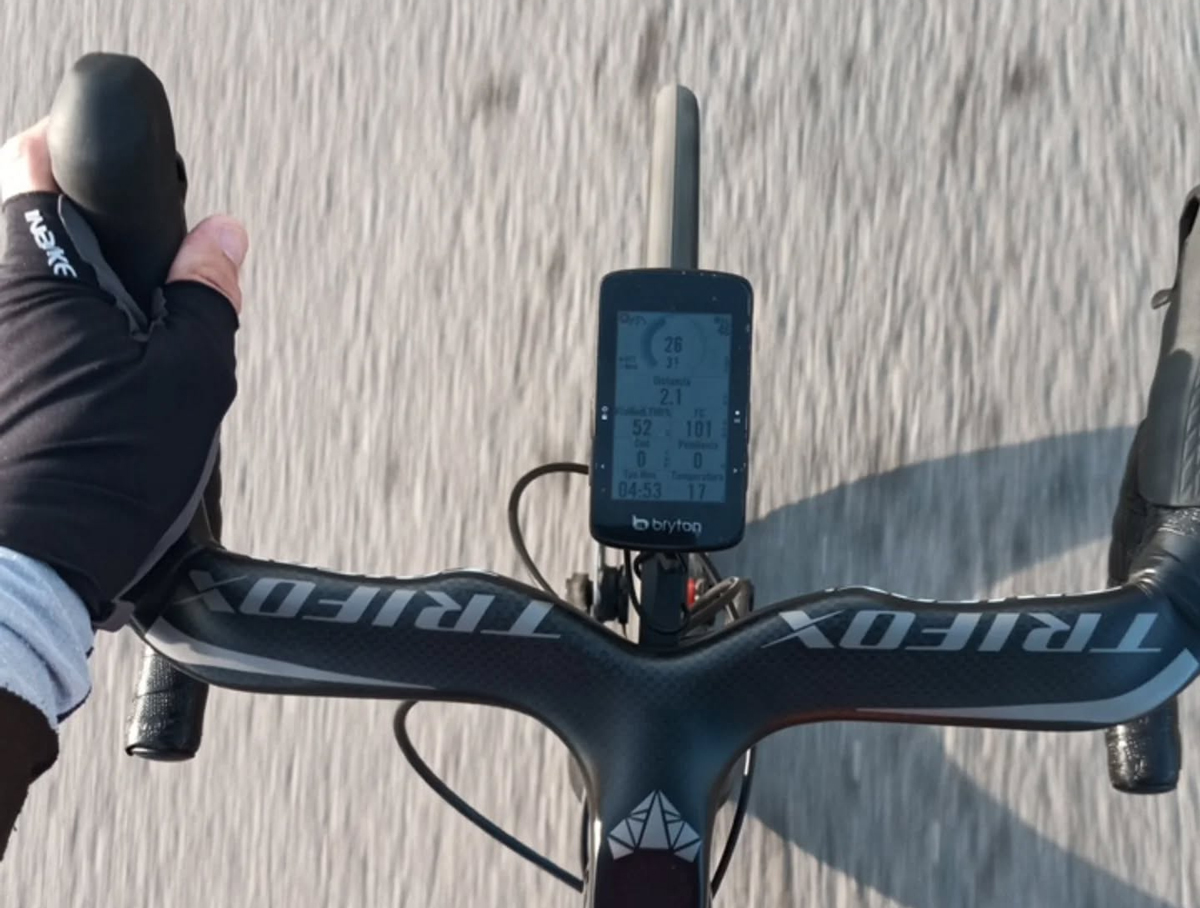
In cycling, every detail matters—especially contact points like handlebars. Enter carbon integrated drop bars, a game-changer for riders seeking speed, comfort, and style. The Trifox DHB500 exemplifies this innovation, merging cutting-edge design with performance to transform your ride. Why Integrated Drop Bars? Traditional setups pair a separate stem and handlebar, creating aerodynamic gaps and added weight. Carbon integrated systems like the DHB500 combine both into a single unit, slashing drag and eliminating weak points. The result? A sleeker profile that slices through wind, translating to free speed on flats, climbs, and sprints. Performance Benefits of Carbon Carbon fiber's magic lies in its blend of lightness and strength. The DHB500 weighs just 296g , shaving grams without sacrificing stiffness. This ensures precise steering and efficient power transfer, whether you’re attacking a climb or cornering at speed. Additionally, carbon dampens road vibrations better than aluminum, reducing fatigue on long rides. Aero Gains & Customization The DHB500's design minimizes turbulence around cables and junctions, crucial for maintaining airflow in critical zones. Its internal routing compatibility (mechanical, electronic, or hydraulic) keeps cables hidden, enhancing aesthetics and aerodynamics. With multiple stem lengths (70-130mm) and bar widths (38-44cm), riders can tailor fit and handling to their preferences—ideal for racers, endurance cyclists, or commuters. Carbon integrated drop bars aren’t just a luxury—they’re a smart upgrade. The Trifox DHB500 offers tangible gains in speed, comfort, and control, all while elevating your bike’s aesthetics. Ready to experience the difference? Explore the DHB500 here and unlock a smoother, faster, and more connected ride.
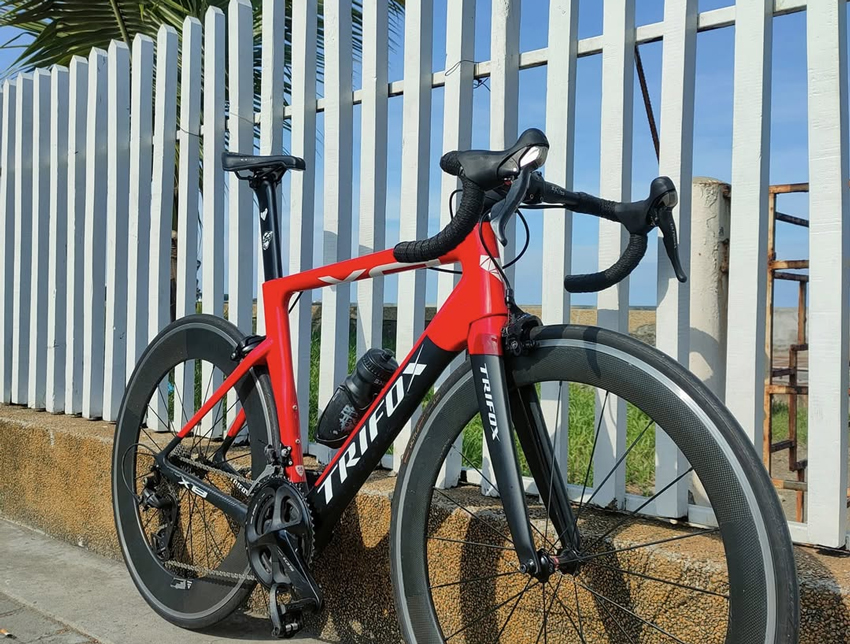
For cyclists chasing every advantage, aero road bikes are essential, blending speed, efficiency, and cutting-edge design. In 2025, the pursuit of performance no longer demands a premium budget, thanks to models like the Trifox X8, which redefines value in the aero category. What Makes a Great Value Aero Bike? The best options balance aerodynamics, weight, components, and price. The Trifox X8 excels here, boasting a full carbon frame with wind-tunnel-optimized tubing, an integrated cockpit, and hidden cable routing to minimize drag. At just 8.6kg (size 56cm), it's lightweight yet stiff, ensuring responsive handling. Compatibility with both mechanical and electronic groupsets (like Shimano 105 Di2 or SRAM Rival AXS) offers customization, while disc brakes and 30mm tire clearance add versatility for varied terrain. Why the Trifox X8 Stands Out Trifox's direct-to-consumer approach slashes costs without compromising quality. Early reviews highlight its agile handling and stability, making it a race-ready choice for crits, fondos, or spirited group rides. Final Thoughts In 2025, aero performance is more accessible than ever. The Trifox X8 delivers pro-level engineering at a fraction of the cost, proving speed doesn't require sacrifice. Ready to upgrade? Explore the Trifox X8 here and join the aero revolution—your fastest ride yet awaits.
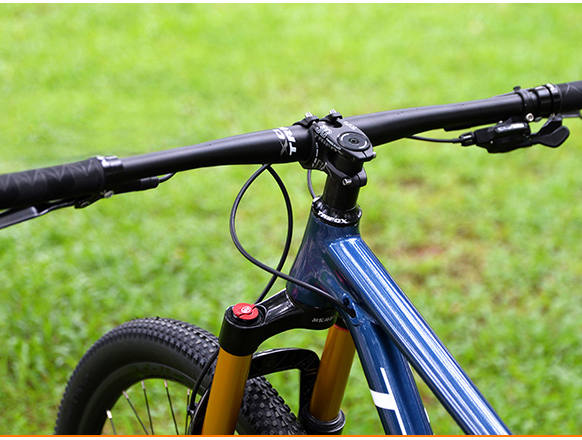
Cyclists love to tweak their rides, and one common question is whether you can swap flat handlebars for sleek, aerodynamic drop bars. The short answer? Yes—but it’s not always straightforward. Why Go Drop Bar? Drop bars aren’t just for road racers. They offer: - Aerodynamics: Lower hand positions reduce wind resistance for faster rides. - Versatility: Multiple grip options reduce fatigue on long journeys. - Style: They give bikes a sporty, performance-oriented look. The Challenges of Conversion Swapping bars isn’t as simple as unscrewing one set and bolting on another. Key considerations include: - Component Compatibility: Flat-bar bikes use different shifters, brake levers, and derailleurs than drop-bar setups. You’ll likely need new integrated brake/shifter units (like Shimano STI), which can be costly. - Geometry Tweaks: Drop bars are narrower and may require a shorter stem to maintain comfortable reach. - Cable Adjustments: Brake and derailleur cables may need rerouting or replacing to fit the new handlebar shape. Enter Carbon Upgrades If you're committed to the conversion, upgrading to carbon handlebars—like Trifox’s lightweight, vibration-damping options—can enhance performance. Carbon bars reduce weight, improve stiffness for responsive steering, and absorb road chatter, making them ideal for riders prioritizing speed and comfort. Step-by-Step Conversion Tips 1. Assess Compatibility: Confirm your bike’s stem diameter (most are 31.8mm) and whether your frame can accommodate drop-bar cable routing. 2. Invest in Components: Budget for drop-bar shifters, brake levers, and compatible derailleurs. Consider bar tape for grip and aesthetics. 3. Seek Professional Help: If DIY mechanics feel daunting, a bike shop can ensure seamless installation and safety checks. Is It Worth It? For casual riders, the cost and effort may outweigh the benefits. But for enthusiasts craving a road bike feel or upgrading to carbon components like Trifox’s handlebars, the transformation can breathe new life into your ride. Converting flat bars to drop bars is possible, but it’s a project best suited for dedicated tinkerers or those willing to invest in professional help. With the right parts—and high-performance upgrades like carbon handlebars—you can unlock a faster, more versatile ride.
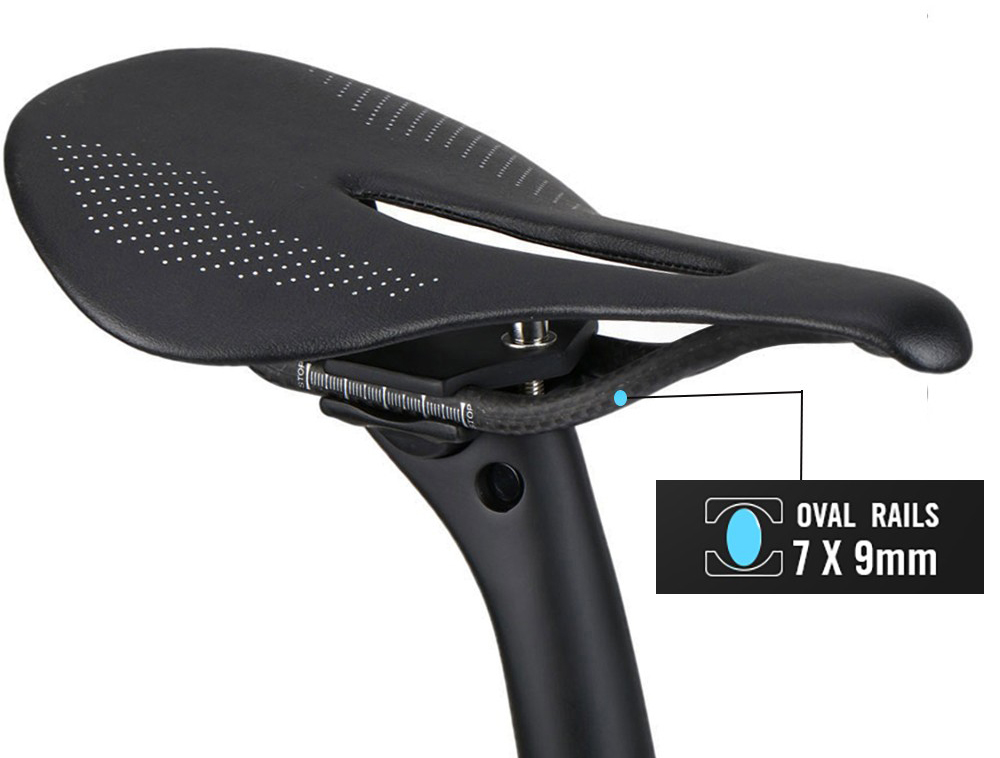
Long-distance cycling demands endurance, stamina, and one often-overlooked essential: a saddle that won’t leave you wincing. Whether you’re tackling century rides, bikepacking adventures, or daily commutes, the right bike saddle can mean the difference between euphoria and agony. Here's why upgrading your saddle matters and how to choose the best one for your ride. Why Saddle Choice Matters Your saddle is your primary contact point with the bike, and poor design leads to numbness, chafing, and soreness—issues that derail long rides. A quality saddle combines three elements: 1. Ergonomic Shape: Curves that match your sit bones and relieve soft-tissue pressure. 2. Strategic Padding: Enough cushioning to absorb vibrations without feeling bulky. 3. Ventilation: Channels or cutouts that reduce heat buildup and moisture. The Carbon Fiber Advantage Carbon fiber saddles, like Trifox's offerings, elevate comfort with cutting-edge engineering: - Lightweight Strength: Carbon shells and rails shed grams while maintaining stiffness for efficient power transfer. - Targeted Flex: Carbon’s natural vibration-damping properties reduce road buzz without sacrificing responsiveness. - Durability: Resistant to weather, sweat, and wear, ensuring longevity for high-mileage riders. Trifox Carbon Saddles: Built for the Long Haul Trifox's range caters to diverse riding styles with features like: - Hollow-Tech Design: A central cutout minimizes perineal pressure and enhances airflow. - Titanium Rails: Lightweight yet robust, compatible with most seat posts. - Adaptive Padding: High-density foam molds to your anatomy over time, balancing support and comfort. Who Needs a Carbon Saddle? - Endurance Cyclists: Reduce fatigue on multi-hour rides. - Road Racers: Prioritize weight savings and aerodynamics. - Adventure Tourers: Seek reliability on rough terrain and varied conditions. Finding Your Perfect Fit 1. Measure Your Sit Bones: Use a gel pad or professional fitting to determine your ideal saddle width. 2. Test Ride: Many brands offer trial periods to ensure compatibility. 3. Adjust Position: Fine-tune tilt and fore/aft alignment to optimize pressure distribution. A carbon saddle isn't just a luxury—it's an investment in pain-free performance. By blending cutting-edge materials with ergonomic design, Trifox’s carbon saddles prove that comfort and speed aren’t mutually exclusive. Whether you’re chasing personal bests or exploring new horizons, the right saddle ensures every mile feels like a victory.
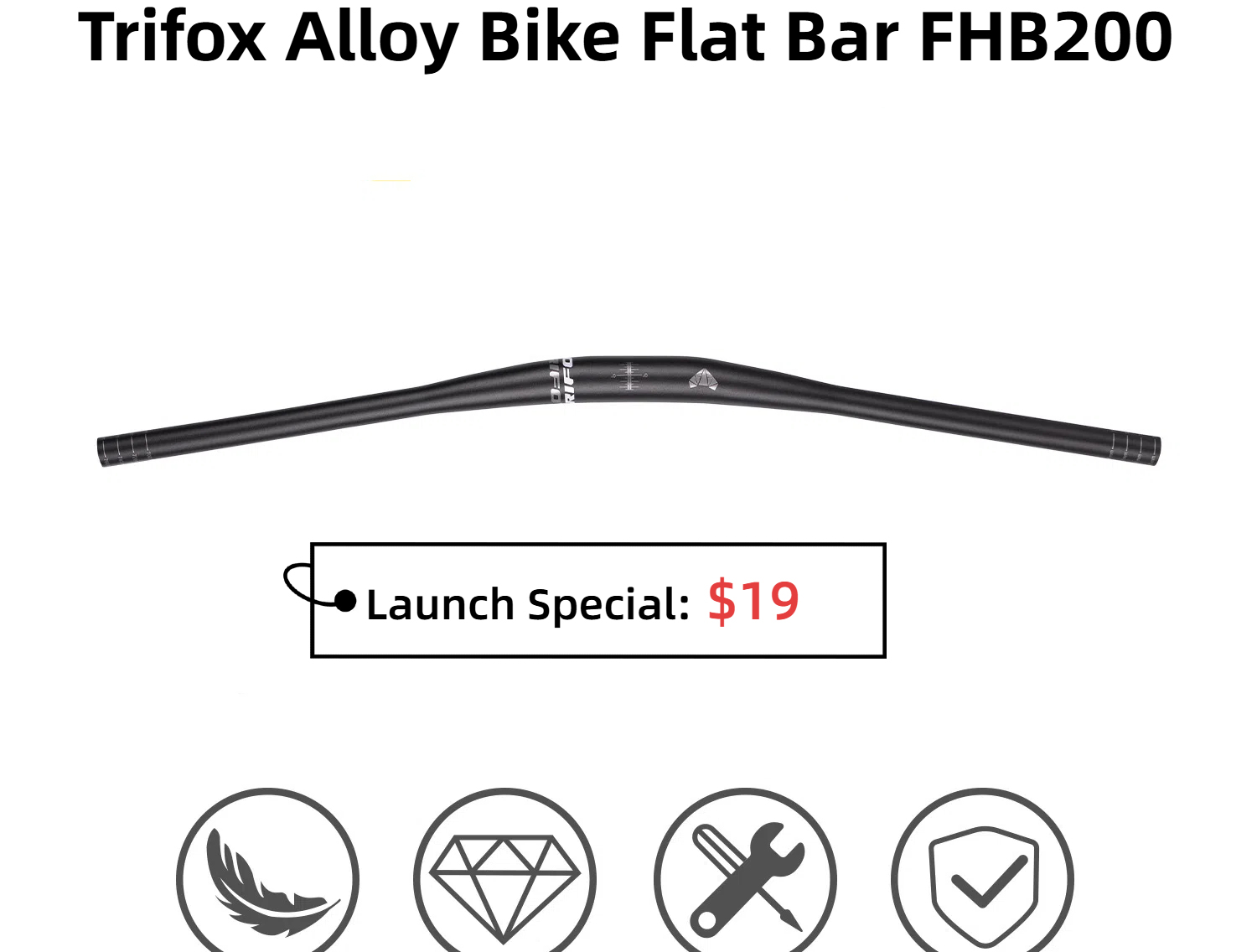
For casual riders and daily commuters, cycling isn’t just about speed—it’s about comfort, control, and reliability. Enter alloy flat bars, the unsung heroes of handlebar design that strike the perfect balance between performance and practicality. Whether you’re navigating city traffic, cruising bike paths, or tackling weekend adventures, here’s why upgrading to an alloy flat bar could transform your ride. The Alloy Advantage: Built for Everyday Riding Aluminum alloy handlebars have long been a favorite for their winning combination of strength, weight, and affordability. Unlike carbon fiber (which prioritizes weight savings at a premium price) or steel (which adds durability but heft), alloy offers a middle ground ideal for riders who value: - Durability: Resistant to rust, dents, and daily wear-and-tear, alloy bars withstand potholes, curb hops, and all-weather commuting. - Lightweight Control: At roughly 30% lighter than steel, alloy reduces fatigue on long rides without sacrificing stiffness for precise steering. - Budget-Friendly Performance: High-quality alloy bars deliver premium features at a fraction of the cost of carbon. Why Flat Bars Rule the Streets Flat handlebars aren’t just for mountain bikes. Their straightforward design offers unique perks for urban and casual riding: - Upright Comfort: A natural, relaxed posture reduces strain on your wrists, neck, and back—a lifesaver during stop-and-go traffic or leisurely cruises. - Instant Maneuverability: The wide grip provides leverage for quick turns, dodging obstacles, and navigating tight spaces with confidence. - Simpler Setup: No complex hoods or drops mean easy access to brakes and shifters, perfect for riders who prioritize simplicity. The Trifox Alloy Flat Bar: Designed for Versatility The Trifox 35mm Aluminum Alloy Flat Bar exemplifies why this style is a commuter’s dream. Key features include: - 35mm Clamp Diameter: Boosts stiffness for responsive handling while remaining compatible with most modern stems. - Lightweight Design: Weighing in at just 280g, it’s agile enough for quick accelerations yet robust enough for loaded panniers. - Multi-Bike Compatibility: Works seamlessly with hybrid, MTB, or commuter bikes, making it a versatile upgrade. - Sleek Ergonomics: A subtle rise and textured grip zones enhance comfort without compromising the flat bar's minimalist aesthetic. Who Should Make the Switch? - Commuters seeking a reliable, low-maintenance handlebar for daily rides. - Hybrid Bike Owners wanting to improve control without a full overhaul. - Leisure Riders prioritizing comfort on weekend trails or family outings. Alloy flat bars aren't flashy, but they're the workhorses of the cycling world—durable, adaptable, and endlessly practical. By pairing affordability with performance, they empower riders to tackle diverse terrain without breaking the bank or their backs.
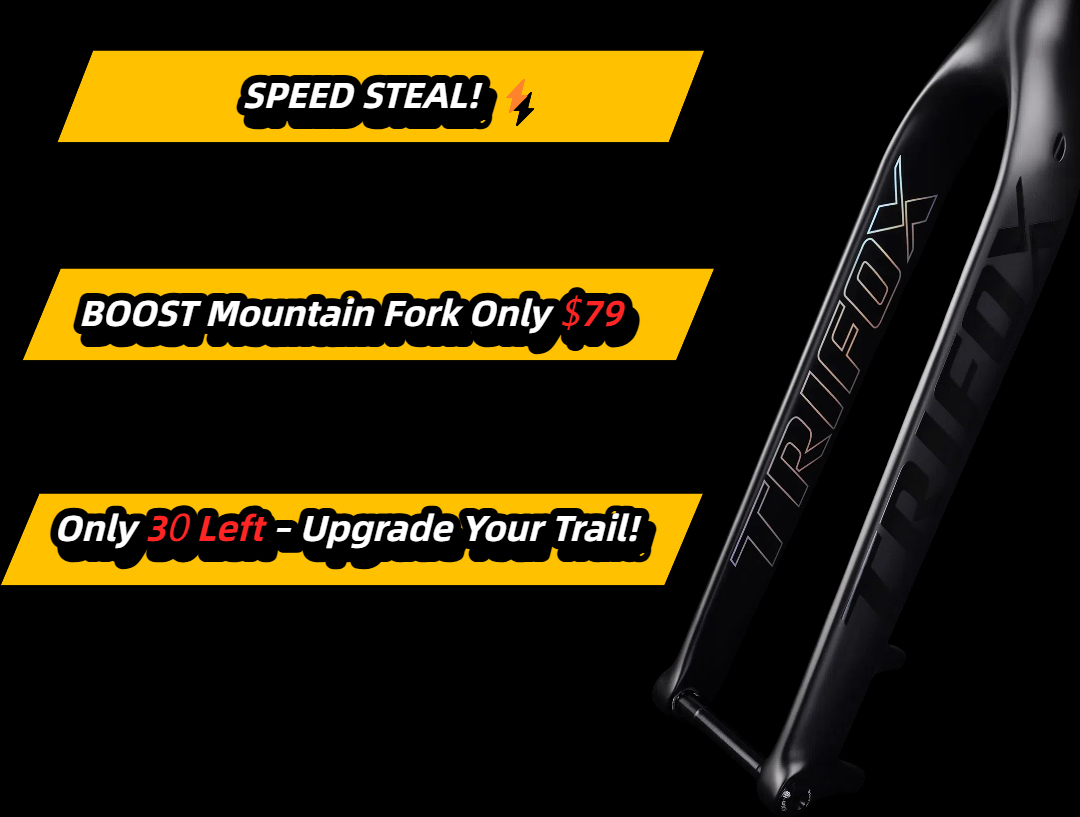
For mountain bikers, a carbon fork is a game-changer—offering lightweight performance, vibration-damping comfort, and razor-sharp steering precision. But high costs often put these upgrades out of reach… until now. Carbon fiber’s magic lies in its blend of strength and featherlight weight. Unlike alloy forks, carbon absorbs trail chatter, reducing arm fatigue on rough terrain while maintaining stiffness for confident handling. Perfect for cross-country riders, commuters, or gravel adventurers seeking speed and comfort. What Makes the Trifox Fork a Steal? - Boost Spacing: Compatible with modern 29” MTB wheels (110x15mm axle), this fork ensures better tire clearance and stiffness for aggressive riding. - Disc Brake Ready: Designed for flat-mount disc brakes, it delivers reliable stopping power in all conditions. - Tapered Steerer: Enhances steering precision and durability, fitting most contemporary bike frames. - Rigid Design: Ditch the weight and maintenance of suspension forks—ideal for riders prioritizing efficiency over rough terrain. Who Should Upgrade? - Budget-Conscious MTBers: Replace a heavy stock fork or upgrade an older hardtail without splurging. - Gravel & Commuter Riders: Add carbon’s comfort to mixed-surface adventures or daily rides. - DIY Builders: A cost-effective cornerstone for building a lightweight, high-performance rig. Carbon forks at this price point are rare—and Trifox’s offering delivers core benefits without cutting corners. Whether you’re chasing PRs on singletrack or smoothing out city streets, this fork proves premium upgrades don’t have to break the bank.
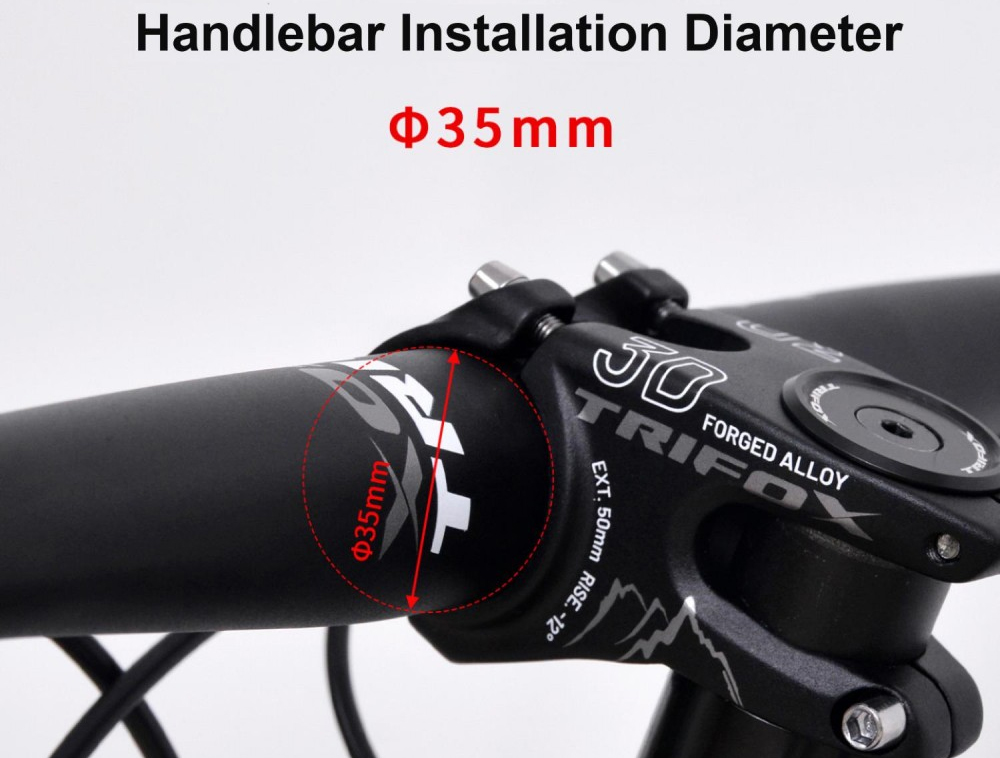
For urban cyclists, navigating crowded streets, dodging potholes, and squeezing through traffic requires agility, comfort, and control—all while maintaining enough speed to make the ride efficient. Enter the flat bar road bike, a versatile machine that blends the best of road bikes and hybrids to dominate cityscapes and tackle adventures beyond the asphalt. Here’s why these bikes are becoming the go-to choice for riders who refuse to be confined by terrain or traffic. Urban Agility, Redefined Flat bar road bikes ditch the traditional drop handlebars of classic road bikes for a wider, flat handlebar setup. This simple change transforms the riding experience: - Better Control: The upright riding position improves visibility in traffic, while the wider grip offers precise steering for weaving through tight spaces. - Instant Braking: With brake levers and gear shifters at your fingertips, stopping power is immediate—a lifesaver in unpredictable urban environments. - Lightweight Speed: Built with road bike DNA, these bikes feature lightweight frames and narrow tires (slightly wider than standard road bikes) for zipping past gridlock without sacrificing efficiency. Comfort That Goes the Distance Commuting or cruising for hours? Flat bars encourage a natural, relaxed posture that reduces strain on your wrists, neck, and back. Paired with ergonomic grips and shock-absorbing features like carbon forks or wider tires, these bikes smooth out rough pavement and cobblestones, making every ride less punishing than a traditional road bike. Beyond the City Limits Don't let the “city bike” label fool you. Flat bar road bikes are built to explore. Their sturdy frames and grippy tires handle gravel paths, packed trails, and countryside roads with ease. Swap slick tires for something knobbier, and suddenly your urban warrior becomes a weekend adventurer—no second bike needed. Who Should Ride One? - Commuters craving speed without back pain. - Hybrid riders ready to upgrade to something lighter and faster. - Casual adventurers who want one bike for pavement, paths, and light off-roading. In a world where cycling needs are as diverse as the riders themselves, flat bar road bikes strike a rare balance: they're fast enough for fitness rides, nimble enough for downtown chaos, and tough enough to escape the urban grind. Whether you're sprinting to work or chasing sunset horizons, these bikes prove that versatility is the ultimate superpower.
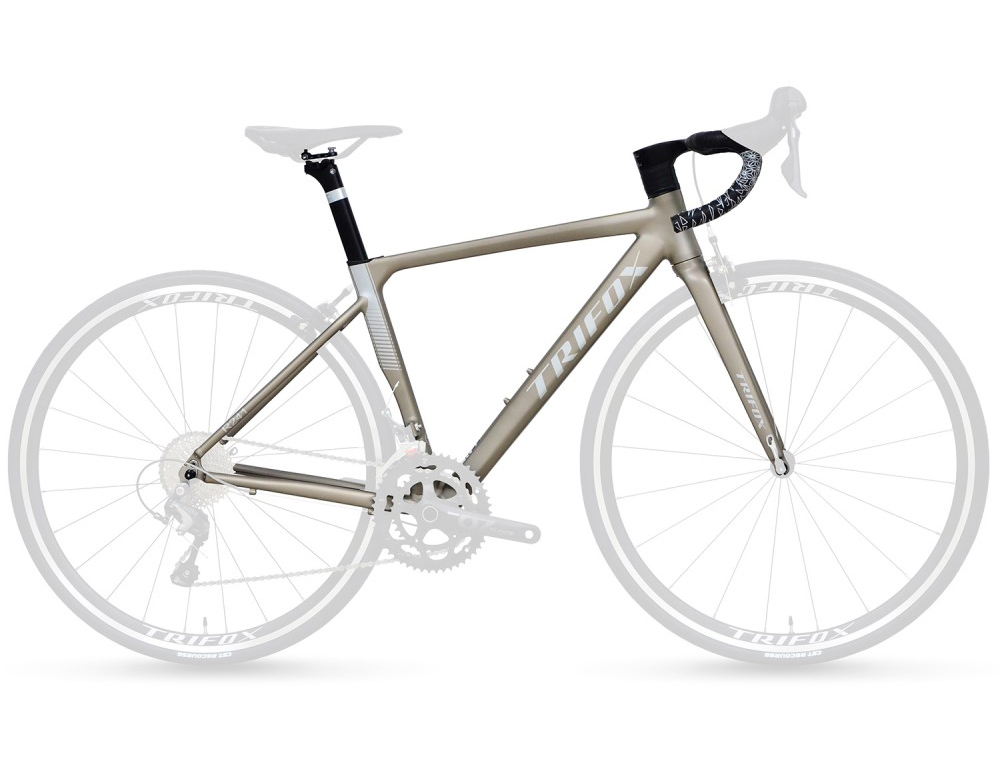
When choosing a road bike, frame material is a critical decision. Aluminum, once overshadowed by carbon fiber, remains a top choice for riders seeking performance, durability, and value. Let's explore why aluminum frames, like the Trifox 6061 Aluminum Alloy Road Frameset, are a smart pick for road cyclists. Lightweight Strength Aluminum alloys, such as 6061, strike an excellent strength-to-weight ratio. Modern engineering ensures these frames are light enough for climbing and sprinting, rivaling pricier carbon options. The Trifox frameset, for example, uses hydroformed tubing to optimize weight distribution without sacrificing stiffness—ideal for efficient power transfer during rides. Durability Meets Affordability Aluminum resists corrosion and handles daily wear better than carbon fiber, which can crack under impact. While aluminum may dent, high-quality frames like the Trifox model are built to endure rough roads and frequent use. Plus, aluminum’s lower cost makes it accessible for riders wanting premium features without the carbon price tag. Ride Quality: Stiffness vs. Comfort Historically, aluminum was criticized for a harsh ride due to its stiffness. However, advancements in frame design—such as tapered tubes, strategic butting, and compliant seatposts—absorb vibrations effectively. The Trifox frameset incorporates these innovations, offering a smoother experience without losing the responsive feel road cyclists love. Performance Versatility Aluminum frames adapt well to rim or disc brakes. The linked Trifox model features a rim-brake design, ensuring reliable stopping power and compatibility with lightweight wheelsets. This versatility appeals to traditionalists and riders upgrading older builds, as aluminum framesets allow customization for racing, endurance, or commuting. Aesthetic Appeal Beyond performance, aluminum frames boast sleek, modern aesthetics. The Trifox frameset’s clean lines and anodized finish prove that affordability doesn’t mean compromising on style. Who Should Choose Aluminum? - Budget-conscious riders: Maximize value without sacrificing speed. - Beginners: A durable, low-maintenance entry into road cycling. - Custom builders: Lightweight framesets like Trifox’s offer a solid foundation for personalized builds. While carbon fiber dominates pro pelotons, aluminum remains a practical, high-performing alternative. The Trifox 6061 Aluminum Alloy Frameset exemplifies how modern engineering elevates aluminum’s strengths—delivering a race-ready ride at a fraction of the cost. Whether you’re chasing KOMs or weekend miles, aluminum proves it’s more than just a “starter” material. Explore the Trifox 6061 Aluminum Alloy Road Frameset here.

















